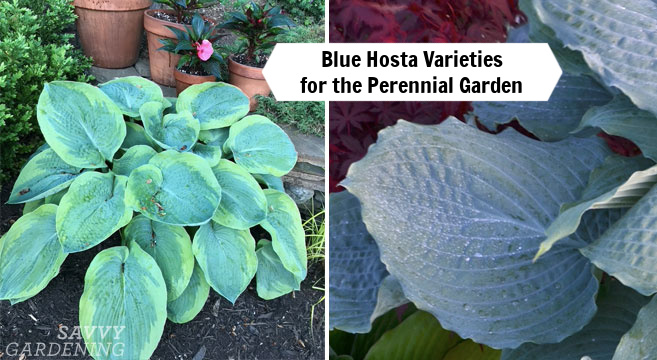This post may contain affiliate links. If you make a purchase through links on our site, we may earn a commission.
Hostas are shade garden foliage staples. And while at a glance, they may all look pretty similar, search around at different garden centers and nurseries and you’ll discover there are a lot of interesting varieties. You’ll find solid-colored leaves in vibrant lime tones or variegated gradients of greens, and different leaf shapes and textures from large and heart-shaped to long and crinkled. What I find to be especially captivating are blue hosta varieties. Blue isn’t as common of a plant color, in foliage or blooms, which is what makes them so unique.
Some of the varieties listed here are diminutive in size, fitting easily in a container or garden border, while others can span a whole garden!
What gives a blue hosta its unique color?
Blue hosta varieties aren’t technically blue. The plants’ leaves are covered in a wax-like coating, which makes them appear to have that blueish hue. This is also described as “glaucous,” which is Latin for greyish blue and used to describe plants with those tones or others that are blue-green.
And while blue in the variety name is a good indication of the color you’ll be getting, there are plenty of others that don’t reveal a hint to the foliage hue in their name.
Depending on the climate and where they’re planted in the garden, the hosta leaves may lose the blue throughout the season as sun exposure, heat, and heavy rains can wear it away, revealing more of a green color. Planting your hosta in part shade, where it only gets a bit of the cool morning sun, can help preserve its color. Full sun can also affect the foliage, by burning the edges of the leaves, turning them brown.
One notable attribute is blue hostas tend to have thicker leaves, which can help protect the plant from slug damage. Unfortunately they’re still tasty to other pests, like groundhogs, rabbits, and deer. And, if there is an especially wet summer, they may still be vulnerable to slug damage.
Favorite blue hosta varieties
There are so many beautiful hostas on the market, this list of blue varieties is a mere fraction of them. When you’re researching any hosta, the listing may describe how it’s a “sport” of another variety. This means it came from a side shoot from the mother plant that produced a different leaf color and/or pattern.
When planting your hosta, amend the area with lots of fresh compost. Hostas need consistent moisture to thrive and don’t grow as well in dry soils. The plants don’t really need a lot of fertilizer if they’re planted in the right conditions. Use an organic fertilizer, like hen manure—paying attention to the label for frequency and dosage. In the summer when your hostas send up their blooms, the flowers will attract pollinators. Mine are always abuzz!
Hosta ‘Frances Williams’
This stalwart breed can span five feet (63 inches) wide! The blue centre of the ribbed leaves is surrounded by a golden/lime green border that looks like it’s been hand-painted. Apparently in the spring, it can be affected by what is called spring burn or spring desiccation burn, which is caused by too much water, causing the yellow edges to turn brown. Protecting the delicate shoots if there is sudden frost in the forecast can help prevent this. Flowers are vibrant white and bell-shaped.

Hosta ‘Blue Mouse Ears’
‘Blue Mouse Ears’ is a smaller, more compact hosta is great for containers, as well as the garden. Hummingbirds will visit the lavender flowers that grow above the blue-green foliage that is thick and heart-shaped.

Hosta ‘Snow Mouse’
I discovered this relative of ‘Blue Mouse Ears’ while touring a garden that was part of Garden Walk Buffalo. The garden and a couple of others inspired an article about pint-sized plants. Because of its small compact size (15 cm high by 40 cm across), ‘Snow Mouse’ is not only perfect for pots, but also a shade border.

Hosta ‘Canadian Blue’
The heart-shaped leaves of ‘Canadian Blue’ are a solid blue-green and prefers shadier spots in the garden. Plants are dense and reach about 20 inches (50 cm) high by 24 inches (61 cm) across.

Hosta ‘Diamond Lake’
With its ruffled foliage, this 2022 Proven Winners National Hosta of the Year winner is a stunner. Part of the Shadowland collection, the thick foliage has a corrugated texture and individual leaves can grow to be 9 inches (23 cm) wide by 11 inches (28 cm) long.

Hosta ‘Hope Springs Eternal’
This new-for-2021 hosta has wavy leaves that are heart-shaped with a large blue centre and a hint of a cream-colored edge. This is another addition to the Shadowland collection of hostas.

Hosta ‘Abiqua Drinking Gourd’
The frosty blue foliage of this medium-sized hosta form cup shapes that will hold water. The plant is heat- and humidity-tolerant with mauve flowers that appear in mid summer.

Hosta ‘Blue Ivory’
I love the contrast of the blue-green centre of the leaves on ‘Blue Ivory’ against the cream-colored border. Plant it so that the “margins,” as the growers call them, provide contrast against other foliage in the garden. This is considered a medium-sized hosta reaching 16 inches (40 cm) in height by 30 inches (76 cm) in width.

Also keep an eye out for these blue hosta varieties
- ‘Mini Skirt’
- ‘Blue Angel’
- ‘Tears in Heaven’
- ‘Dancing With Dragons’
- ‘Valley Glacier’
- ‘Lucky Mouse’
- ‘Bedazzled’
- ‘Dream Queen’
- ‘Waterslide’
Shade plant ideas
- Shade container gardening
- Groundcovers for shady spots
- Plants for dry shade
- Heucheras: Versatile foliage superstars
- Brighten up dark areas of the garden with annual flowers for shade
- Shade-loving perennial flowers: 15 beautiful choices




I’ve grown Hosta Elegans for about 30 years! It’s blue and looks like it was quilted! Friends have received some from mine. A favorite plant!